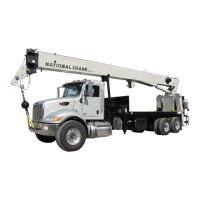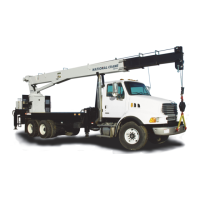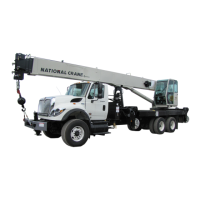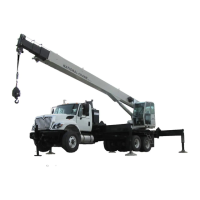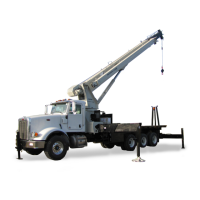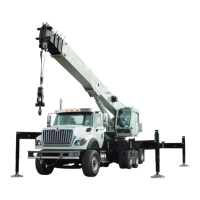National Crane Published 5-27-2018 Control # 039-06 7-15
800D SIDE SHIMMING OF BOOM SECTIONS
crane movements. See Specification Section for pressure
settings.
The large single section control valve supplies oil to hoist up
and down. The inlet section contains a screw adjustable
main relief. The first work section of the multi-section main
control valve controls turn right and left. This work section is
supplied oil by the main inlet section which contains a screw
adjustable relief valve. The remaining work sections are
boom telescope, boom lift, and outrigger functions in that
order. The oil to these sections is supplied by the mid inlet
section which also contains a main relief valve. The hoist and
the main circuits are all connected through shuttles to a
pressure gauge located on the control console.
This system provides additional hydraulic pressure to the lift
cylinder to raise the boom from a negative angle back to zero
degrees. When the boom is below zero degrees and the
lever is thrown to provide oil to the bore side of the lift
cylinder the system relief cartridge in the main control valve
is shifted to provide a higher pressure to the control valve.
The relief valve in the mid-inlet of the control is designed to
have two pressure settings. These pressures are listed in the
“Specifications” section in the front of the Owner’s Manual.
The hydraulic oil is supplied by a truck frame mounted oil
reservoir, which is equipped with a replaceable canister type
return oil filter. The truck power take off driven hydraulic
pump is sized to supply oil to the hoist circuit, the boom lift
and telescope circuits and the turn function at specified
pump shaft speed. Higher pump speeds may result in
excessive heat generation in the hydraulic system. The
pump is not bi-directional and can be used when the shaft
rotates only in the proper direction. If you need to verify or
change pump rotation, contact your National Crane
distributor or Manitowoc Crane Care.
The crane hydraulic system includes a Rated Capacity
Limiter (RCL) system. This system monitors lift cylinder
pressure. As the pressure in the lift cylinder approaches a
maximum predetermined level, which can be monitored on
the RCL display console, a signal is sent to a solenoid which
dumps oil flowing to crane functions which increase the over
capacity condition.
All load bearing cylinders on this machine are protected from
inadvertent movement or collapse due to hose failure by pilot
operated check valves or by pilot operated counterbalance
valves if overhung loads must be controlled.
The standard swing gearbox is locked in place by an
integrally mounted spring applied brake and a dual
counterbalance motor holding valve. The swing brake and
counterbalances are piloted open and closed by operating
swing left or right and are automatically reapplied by ceasing
the swing function. Maximum swing speed can be limited
using the swing speed adjustment valve.
See “Specifications” section for system pressures and flows.
OPTIONAL HYDRAULIC CAPACITY ALERT
SYSTEM
System Adjustment
The hydraulic capacity alert system should be checked for
proper adjustment during initial crane startup and quarterly
thereafter. The procedure for proper adjustment should be
performed as follows: Trapped air must be bled from the
system before adjustments are made.
1. Remove the console cover depending on crane model.
Before loosening any fittings, support the boom.
2. Start the truck and set the crane up for operation as
prescribed in the “Safety and Operation” Section.
3. Select a test weight that is equal to crane capacity at an
intermediate boom length and radius. Work with loads
which have loaded boom angles near 30°. Starting with
the boom at the chosen reference angle and a radius
less than the chosen radius, pick the weight up with the
hoist and begin extending the boom. As the boom is
extending, lower the load with the hoist to keep the load
near the ground. Monitor the load range gauge located
in the console as the boom is extending. The gauge is
plumbed directly into the lift cylinder pilot line and the
pressure reading should increase to what is defined as
capacity load pressure as the selected intermediate
boom length and radius is reached. The intermediate
boom length is determined by a line and corresponding
dimension decal on the side of the second section
boom. The chosen radius is measured from the
centerline of rotation to the loadline.
If the gauge reading does not increase while extending,
lower the load to the ground and check the system
plumbing according to the hydraulic schematic.
Replumb the system according to the schematic and
illustrated parts page or replace faulty pressure gauge.
Before loosening any fittings, support the boom.
When the pressure reaches capacity load pressure, the
overload system should activate and boom extension
will stop. This is defined as trip pressure. This point
should be at or very close to the red/yellow color change
on the load range gauge.
4. Trip pressure should be reached as the boom extension
reaches the chosen radius. If the overload system trips
Fo
r
Reference
Only
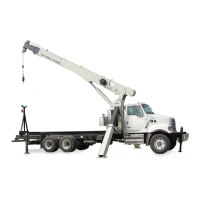
